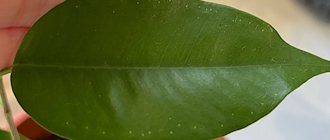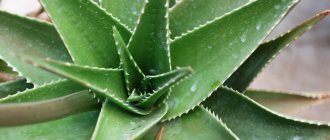Photo of ficus lyrata Ficus lyrata - an evergreen perennial tree of the mulberry family, which began its existence as an epiphyte located at the top of the crown of other trees. In nature it also develops as an independent tree up to 15 m high.
The homeland of ficus lyreate is the tropical regions of West Africa. When grown indoors, it is a tree-like plant up to 3 meters high with large dense wavy leaves with bright, pronounced veins. This is an easy-to-care, intensively growing plant whose annual growth is 25 cm.
Also see how to grow ficus microcarpa and ficus bengal at home.
| An intensively growing plant whose annual growth is 25 cm. |
| At home, ficus does not bloom. |
| The plant is easy to grow. Suitable for a beginner. |
| Perennial. |
What does Ficus lyreate look like, what family does it belong to?
Ficus lyre (lat. ficus lirata) belongs to the mulberry family. It is an evergreen deciduous plant. It can reach a height of 2.5 m. The trunk is straight, the leaves are large, up to 45 cm long. They are smooth to the touch. The foliage looks very beautiful and decorative.
Common varieties
Most often you can find ficus varieties:
- Columnaris – tall variety;
- Little Fiddle – medium height;
- Bambino - short;
- Phyllis Craig is a variety with a compact crown.
Decorative view of ficus lyreate
The last two are best suited for planting at home. The homeland of the ficus lyreate is Western Africa. The plant grows in tropical forests.
Ficus: history
Ficus comes from the Mulberry family and grows primarily in the tropics. Much less frequently, its subspecies can be found in the temperate climate zone. Southeast Asia is considered its homeland. It is a useful plant. Almost all ficus trees are rubber plants (therefore, the second name for ficus is rubber tree), some produce edible fruits and are used as medicinal raw materials.
Ficus is an ancient plant that was known back in Ancient Egypt. It is approximately five thousand years old. During this time, he adapted to all living conditions, so keeping him is not so difficult. In India, ficus is called a sacred plant and is often found in temples. It is believed to bestow spirituality and enlightenment.
In total there are more than two thousand varieties of this tree.
Features of flower care at home
Unlike most varieties of ficus, this variety is demanding in care.
Temperature
Ficus rubber - home care
Ficus lyreformis is a heat-loving plant. In summer, the room temperature should be at least +25 ℃. In winter, it is enough to maintain it at a level of 17-22 ℃ above zero.
Note! It is not recommended to leave the plant in a draft - this may cause the root system to die.
Lighting
Good lighting at home is the key to successful cultivation of this type of ficus. It is best to place pots on windows facing east. Bright sunlight is detrimental to the plant, and the eastern windows have soft, diffused light.
Watering
Depending on the time of year, watering features will differ. In winter, the amount of irrigation is reduced. In summer, on the contrary, watering should be abundant and frequent. The water is allowed to settle for 24 hours before irrigation. If you water with unsettled water, white streaks will begin to appear on the leaves.
Spraying
A lot of dust accumulates on the leaves, making regular spraying and wiping necessary. They need to be cleaned of dust several times a week. In summer they wipe more often.
Humidity
Since ficus lyreate is a tropical plant, it needs high humidity (at least 70%). To increase humidity, you can place the pot in a tray with wet expanded clay, wipe the leaves with a sponge more often, or use a humidifier.
Priming
Soil composition for ficus:
- turf land (3 parts);
- peat (1 part);
- coarse river sand (1 part).
Before planting, all ingredients are thoroughly mixed to obtain a homogeneous mass.
Feeding
Caring for ficus lyreate at home involves regular fertilizing. Fertilizers are activated during the plant’s active period, which lasts from March to September. They are applied twice a month. Fertilize with fertilizers for ficus or decorative deciduous crops.
Important! When fertilizing with mineral fertilizers, make sure that the solution does not get on the leaf.
Peculiarities
This is an ornamental plant that is classified as evergreen. Its name comes from the Latin lyratus - “lyre”. It received this name due to the fact that its leaves are shaped like a lyre or a violin. For the same reason it is also called violin ficus.
Africa is considered the homeland of this species. In nature, it reaches as much as twelve meters (how big it can be, you can see in the photo - the lyre-shaped ficus is several times taller than a person!) and therefore has every right to be called a tree. Found mainly on forest edges. In the depths of forests, it often grows not independently, but as an epiphyte (that is, located on other trees). This ficus differs from other species in its love of solitude and needs a separate space without neighbors. Can't stand being disturbed. It is not rubbery.
Lyre-shaped ficus can be successfully grown both at home and in the work area.
When and how does it bloom
Ficus - home care, ficus diseases
At home, ficus does not bloom. The plant can bloom only in its natural environment or in a botanical garden. Sometimes you may not even notice the inflorescences. Ficus lyrata grows only upward and is a fairly tall, erect plant. Not all gardeners may like this. In order for the ficus to produce lateral shoots, it must be pruned. To do this, the top of a flower whose height has reached 70 cm is cut off above one of the internodes. This ensures the formation of the crown.
Ficus pruning is an important part of care
Appearance
In captivity, the lyre-shaped ficus grows to a maximum of two and a half meters. The tree has a straight, rough trunk with brown-gray bark, which is covered with leaves - wavy, large (up to 50 centimeters in length), dark green, with lighter veins. They cannot be cut. The lyre-shaped ficus is larger than its comrades. Its flowers are not very beautiful, and its large fruits, unlike the fruits of some other species, are inedible and green. Getting this plant to bloom is quite problematic.
How does ficus lyrera propagate?
There are several ways to propagate ficus at home.
Germination of seeds
It is impossible to obtain seeds at home. You can only buy them. How to propagate by seeds:
- before planting, planting material is soaked in water;
- after a few days they are planted in the ground;
- water and cover the pot with film;
- shoots should appear in about 10-14 days;
- after this the film is removed.
On a note! Seedlings are planted when their height reaches 5-7 cm and several full leaves appear.
Rooting cuttings
Before cutting the cuttings, the soil is carefully weeded so that the plant is saturated with water. They begin planting the next day. Planting ficus cuttings:
- A powerful shoot is chosen for the cutting.
- Cut it at an angle of 45 degrees.
- The lower leaves are torn off, leaving 2-3 upper ones.
- The cutting is placed in a glass of water so that the juice comes out of it.
- Then dry it.
The cutting can be left in water and wait until roots appear. Then replant into the ground. Or immediately plant it in the soil and do not forget to water it regularly.
Propagation by cuttings
Air layering
How to propagate by air layering:
- select the location of the layering;
- from the top of the plant should be at least 60 cm;
- at this point, the leaves are torn off and two cuts are made (the distance between them is at least 3 cm);
- the cuts are treated with a root formation activator;
- then the place is wrapped in moss.
After a few weeks, a shoot should appear. There are no other ways to propagate ficus.
Propagation by cuttings
To propagate the lyre-shaped ficus, it is convenient to use apical, semi-lignified cuttings, which are cut during the formation of the plant crown. The cuttings must be placed in clean water for rooting. After the first roots appear, you can plant a loose and nutritious substrate. If the cutting is planted directly into the ground, then it needs to be provided with comfortable conditions and ventilated daily.
Transfer
Ficus grows very quickly, so it will have to be replanted often. The transplant is carried out in the second ten days of April. The process involves the following:
- remove the plant from the pot, cut off all the roots that have begun to grow upward;
- remove rotten roots;
- the new capacity should be 30% larger than the previous one;
- pour some of the soil into the pot and place the plant;
- Fill the container with soil and compact it lightly.
At the end of the transplant, be sure to water with plenty of warm water. Wood ash or vermicompost is added to the water.
What to do after purchase?
The young plant requires annual replanting. If the purchase took place in the spring or summer, it is better to do it right away. In autumn and winter - you can wait a little. The best time to transplant is spring. The pot must match the size of the flower and not be elongated or round. It is better to give preference to ordinary uncoated clay pots. The appearance of the plant directly depends on the shape of the pot. But you can choose another material.
Important: if the ficus grows in a pot that does not allow air to pass through, it will need more light.
The bottom must be covered with a drainage layer. There are also certain requirements for the soil. It must be air-permeable and fertile, otherwise the plant will not be lush enough. There are special soils on sale that are ready for planting ficus.
Possible problems in cultivation and diseases
If you care for it incorrectly, the ficus will hurt. It is due to improper care or lack thereof that problems most often arise.
Drops buds and leaves
The reason for dropping leaves is low humidity. In this case, they also turn yellow. Leaves should be wiped and sprayed more often. Place a container with wet expanded clay nearby.
Additional Information! If the leaves become small and begin to fall off, then the plant does not have enough nutrients.
The leaves are turning pale
If the leaves turn pale, it means the plant is not getting enough sunlight. In this case, it is moved to the sun. Leaves may turn pale due to chlorosis. Spraying with ferovit will help cure the disease.
The tips of the leaves are drying out
If the ends begin to dry after transplantation, it means the roots have been damaged. Also, the reason may be dry air or lack of potassium in the soil.
The lower leaves fall off
The lower leaves may fall off naturally if they are old. Leaves fall in autumn or early winter as part of the natural process of leaf change.
The lower leaves are falling
Pests
Ficus pests:
- spider mites (spray with Vertimek, Mavrik);
- orange aphids (spray with tobacco decoction and soap);
- scale insects (wipe with alcohol and rinse the foliage in the shower);
- mealybug (treat the plant with fungicides).
Insects often cause diseases.
Other problems
Another problem when growing ficus is disease:
- gray rot;
- sooty fungus;
- powdery mildew;
- cercospora;
- root rot.
To combat diseases, plants are sprayed with fungicides. For powdery mildew, wiping the foliage with a soapy solution helps.
Additional Information! With gray rot, the affected parts are cut off, the soil is dried or changed. Cercospora infection is treated with antifungal drugs.
Is it possible to keep a ficus at home?
It would seem that ficus is a wonderful plant that is not only very beautiful, but also capable of purifying the air. Of course, you need to breed it! However, there are many different signs. So, some believe that ficus contributes to the development of vices - envy, jealousy. Slavic beliefs said that in a house where there is a ficus, there is no love. Ficus is also called undesirable for single ladies - supposedly it drives away possible gentlemen.
But all foreigners, on the contrary, say only good things about ficus. It is considered an ideal plant for strengthening family relationships, as it has a positive effect on the atmosphere in the home. The Chinese believe that ficus gives comfort and helps in solving family problems and needs, and also cleanses the aura of negative influences. Ficus also helps to get pregnant because it is the keeper of the hearth.
To plant or not to plant a ficus, to believe or not to believe this or that sign - everyone decides for himself. But one thing is undeniable: this is a truly spectacular plant that will delight the eye all year round.
Benefits and harms
When contacting the plant, it is advisable to use protective gloves. Ficus sap can cause an allergic reaction.
But still, this tree-like plant does more good than harm.
Many medicines and ointments are made from the juice of the lyre-shaped ficus. They are used to treat female diseases. They also treat hemorrhoids, radiculitis, osteochondrosis, and arthritis.
Scientific name
Ficus "Lyrata" has a scientific name - Ficus lyrata. It is increasingly found in homes and is becoming a decoration for offices.
Signs and superstitions
Ficus is the hero of many beliefs and superstitions. Married couples should not grow this plant. It is believed that a ficus given as a wedding gift will lead to the breakup of a family due to the departure of a man. For the same reason, young single girls should not grow it. It drives men away and prevents new romantic relationships. However, this plant is believed to bring money. Therefore, it is often placed at work, on window sills and work tables. It is believed that ficus helps pregnant women to endure pregnancy more easily, prevents miscarriages and facilitates the birth of a child.
This belief also says that if you are just planning to have a child, the ficus will contribute to this. Having knowledge about growing this plant, you can arrange your home and introduce the flower as a decorative element. Considering that it is not difficult to propagate, it will be possible to decorate the house with not one, but several plants of this type.
Description
The tree's homeland is the tropical forest of West Africa.
Ficus lovers should pay attention to these popular varieties.
Bambino
The plant forms a compact crown and densely spaced leaves that grow up to 24 cm.
Bambino
Phyllis Craig
The variety was bred in 1956. It has a compact crown, the leaves reach a length of 34 cm.
Phyllis Craig
Ficus lyre has a positive effect on the energy of the home and improves mood. Since ancient times, it has been noticed that people who grow this tree in their homes get sick less often and recover faster.
In order for family relationships to be harmonious, as well as to add to the family, it is believed that a flowerpot with ficus should be placed in the bedroom.
Where to put
Ficus lyre-shaped tolerates partial shade well, even over a long period of time. The ideal place should be with diffused light. There should be enough light. In diffused light, ficus grows and develops better.
- the lighting is not bright, but sufficient for the plant. Avoid direct sunlight, which can cause sunburn on the leaves. Despite the leathery leaves, burns can leave spots on the leaves. Thus, its decorative effect is lost. As mentioned above, lyre-shaped ficuses can tolerate shading, but additional lighting can be used, using spot light from a lamp or using phytolamps for plants.
- the temperature for growing this ficus is 15 degrees, but this is in winter. In the summer it can be from 17-20 - this is at night, during the day it is not higher than 30 degrees. If you take your ficus out into the fresh air, the temperature should not drop below 10 degrees. Avoid sudden temperature fluctuations and drafts. This may cause leaves to drop.
humidity can be maintained by constantly spraying the leaves, or by wet cleaning the ficus. To do this, wipe the leaves with a damp cloth. This will remove dust and dirt on the leaves. Improve photosynthesis and increase humidity. You can also use vessels with water, but this is not always possible or does not look entirely aesthetically pleasing. You can pour water into the tray after filling it with expanded clay. But if the ficus is tall enough, then you can use a humidifier.
How to form a crown at home?
In the process of pruning, the ficus can be given the outlines of animal silhouettes. But this is more within the capabilities of experienced gardeners. For beginners, it is better to choose the classics - geometric shapes or multi-tiered trimming.
To do this you need:
- think over the shape of the crown and its size in advance;
- do not leave bare branches without buds, otherwise the flower will look untidy;
- the top bud should always be directed outward;
- thin out internal shoots if there are many of them.
But these are not all the ways to form a crown. To improve it, improvised means are used.
No top trimming
You can give the top the desired shape using special preparations or manipulations with the location of the pot.
To form a crown, you can use the following techniques:
- Support devices. They direct the growth of shoots in the right direction.
- Slope of horizontal branches. This helps them grow upward.
- Chemical growth stimulants.
- Rotate the pot 180 degrees. Activates the growth of shoots on the bare side of the ficus.
- Planting shoots of different heights in one flowerpot - for a multi-tiered crown.
- Additional lighting – to create a rounded shape.
Pruning
To create a symmetrical crown, you need to follow the recommendations:
- Trim young shoots.
- Pinch out the side buds.
- Don't leave stumps. They can become a source of infection.
- The cuts on the trunk should be arched or triangular.
The crown can be given a special shape by grafting. But this is not always effective. Ficus trees produce a lot of juice containing alkaloids. That's why they don't grow together well.
How to make a tree grow to the sides?
To do this, you need to enhance the growth of side shoots.
This is done as follows:
- the highest point on the stem is selected;
- An oblique cut is made above the bud at a distance of 7-8 cm from the leaf;
- use a wet cloth to wipe off the milk flowing down the barrel;
- the sections are sprinkled with ash.
After this, the plant needs special attention. Then it will quickly recover. After 2 months, these manipulations can be repeated. This will be an additional stimulus for the growth of side shoots.
How to transplant?
After purchase, the ficus lyre-shaped undergoes adaptation for 2 weeks. For planting, a special soil substrate is used. Initially, the roots should be completely cleared of transport soil. The pot is purchased based on the size of the root system. To make it easier to regulate the watering regime, add a layer of drainage to the bottom of the pot.
The lyre-shaped ficus is transplanted in the spring (April). The pot is selected with a diameter 2 fingers larger than the previous one; the optimal material for making the container is clay.
Useful tips for care after pruning
If pruning is done correctly, the plant looks neat and gives the impression that it has not been touched at all. To prevent the ficus from getting sick, it is necessary to periodically inspect the plant for bacterial infection and follow some recommendations:
ficus after cropping photo
- A freshly pruned plant should not be sprayed; moisture that gets on the cuts can provoke the development of the disease;
- do not place the pot with ficus in a draft or in a cold room, the temperature should not be lower than room temperature;
- do not over-moisten the soil;
- Be sure to feed the plant; in the spring this can be done immediately after pruning.
If you follow all the rules and recommendations, after pruning the ficus will form a crown of the desired shape, but in order for this shape to be maintained permanently, pruning must be carried out regularly, with an interval of 2 months.
Ficus is an unpretentious and hardy crop. But for harmonious growth and the formation of a neat crown, the plant needs to be pruned. This procedure has its own characteristics.
How to trim correctly to give a beautiful shape?
During the pruning process, it is advisable to follow the following recommendations:
- Wash your hands with soap. Disinfect tools with alcohol or heat their metal parts over a fire.
- Carefully examine the plant. You need to plan in advance which branches are best to cut.
- First, dry branches are removed. After this, you can begin to form the desired shape.
- For convenience, the boundaries of removal can be marked with colored tapes or chalk. Then there will be less risk of accidentally cutting off the wrong section of the shoot.
- The cut is made strictly above the kidney.
If it is necessary to trim a small section of the stem, pinch it. The shoots obtained during shearing are not thrown away. This material is useful for propagating ficus.
How to trim so that Benjamin is fluffy and lush?
The crown will be thick if you do the following:
- shorten the trunk by 5-10 cm;
- periodically trim the remaining shoots to activate the lateral buds;
- Prune both outer and inner branches.
After this, the plant almost does not grow upward. It begins to actively grow in breadth. Removing the top of the trunk can only be done once a year. The lateral processes are trimmed 2-3 times a year, but no more.
Attention! When trimming side stems, the direction of growth of the bud next to which the cut is made must be taken into account. The shoot will grow in the same direction.
What should I trim to make the plant bush?
In order for the ficus to take on the shape of a bush, you must:
- Trim off the top of the central stem. If the height of the tree is less than 80 cm, the top is shortened by 10-15 cm. With a height of 1 m, you can cut it to 20-25 cm.
- Shorten side shoots that have reached a length of 10-12 cm by 2-3 cm.
- As they grow back, cut off the side shoots again.
After deep pruning of the trunk, the plant gradually takes on the desired shape. And if there is high humidity in the room, the ficus grows aerial roots. They can be directed into the soil. Then they will gradually take root and form a banyan tree with a spreading crown.
Rules for the formation and selection of inventory
For trimming you need to use tools that are convenient and familiar. The main thing is that they are sharp and clean. You can take:
- pruner;
- scalpel;
- garden knife.
To form a ficus you may need:
- garter - ropes, wire, pieces of fabric;
- removal of latex - gauze or cotton swabs, clean rags, napkins;
- treatment of wound surfaces - garden pitch, crushed activated charcoal or charcoal;
- support – pipe covered with coconut fiber;
- stimulator – cytokinin paste;
- to protect hands - gloves.
Pruning and shaping the crown requires following some rules:
- Do not thicken the ficus too much. Leaves should grow freely without interfering with each other.
- Branches should be cut at a right angle, 1-2 cm above the leaf. If the crown is going to be used for propagation, and the internode is too long, the lower part of the cutting is cut off additionally.
- Forming or pruning a weakened, diseased plant cannot be carried out.
- When transplanting, the trunk of the rubber-bearing ficus can be slightly deepened. Sometimes this is enough to increase the stability and decorativeness of the tree.
- With a high probability, after pruning, a side shoot will appear from the nearest upper bud. This way you can control the direction of growth of the ficus.
- It is often advised to remove the milky juice after shaping or trimming and not treat the wound surface with anything, but this is wrong - there is a risk of infection. In addition, activated carbon or garden pitch stops the leakage of latex, and Elastica consists of 15% of it. The top of the trunk will become dry, and the nearest bud and leaf may disappear. This is clearly visible in the photos and videos presented by flower growers who took 1-2 minutes to treat the wound surface.
- Sometimes when pruning and shaping the rubber ficus, it is advised not to leave stumps. But some of the soft wood will still dry out, and if there is not a piece of the stem at least 1-2 cm above the leaf, it will definitely grab the nearest bud with a plate. You'll have to repeat the trimming. It is better to let the process take its course, and then, without affecting living tissue, carefully remove the dried area, leaving 1-2 mm.
- It is recommended to work with gloves so that the rubber sap does not cause irritation when pruning.
- Ficus formation is carried out simultaneously or after the start of feeding. The plant will need additional nutrients to support the growth and development of new branches.
- The transplant is done a few weeks after pruning or shaping. Carrying out simultaneous operations is a lot of stress and greatly depletes the ficus.
Timing for the procedure
How to make a ficus branch and how complex is such a set of measures? The result will certainly satisfy you if you not only study the necessary principles of the procedure, but also determine what time of year it is best to carry it out. It is possible to get a branched crown from a ficus, but it is better to start pruning in the spring. With the onset of spring, the plant wakes up and all vital processes are activated. If you start pinching the flower at this favorable time, the pruning procedure will not be too stressful for the plant: all the “wounds” will heal instantly. In addition, it is in the spring that young buds form on the plant stem and side shoots develop.
That is why there is no more suitable time for the formation of a ficus crown than the spring period, or rather the end of winter - the beginning of spring. Remember, it is unforgivable to delay with this procedure. If you start pruning your home ficus in mid-spring, the result may not be of very good quality. The thing is that when sap flow is active, shortening the branches can awaken the flower and stimulate its growth as a whole, but the new side shoots will be too thin.











